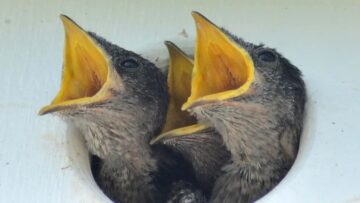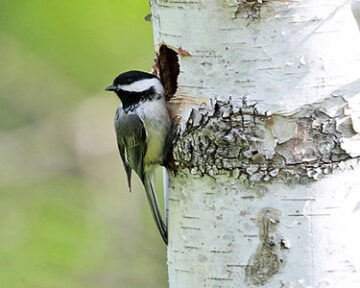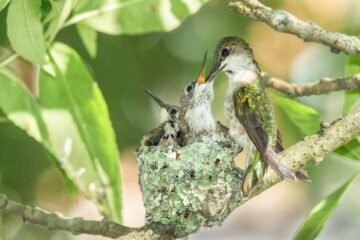by Carol A Westbrook

As the days get longer and warmer and more humid, and the early spring flowers start to bloom, and the flowering trees show their finest… there’s an anticipation in the air…Then suddenly one morning you hear it—the birdsong is back. After a winter of silence you can now hear the birds. The migratory birds are returning from the south.
The towns that lie at the southern end of Lake Michigan have a special significance for migratory birds, because we are along the main flyway. As the migratory birds fly north they come upon a large body of water they must cross—lake Michigan. Tired of flying almost non-stop, eating insects that they catch on the wing, avoiding predators, they stop. They stop at an area with an abundance of trees, and they find wetlands, fields, gardens, and even birdfeeders remembered from last year. Refreshed, some resume flying around or over the lake headed to their ancestral homelands; others decide to remain in the area and breed. Because birds of the same species tend to move north at about the same time they arrive within a few days of each other. Because of the relatively large number of birds of the same species, finding a mate is straightforward.
This year I was fortunate to have several birdhouses and feeders under the eaves in front of the house, near a window where I generally sit and do my writing. I was able to follow the nesting and breeding behavior of several species of birds—the black-capped chickadee, the house sparrow, and the ruby-throated hummingbird. These birds are known as altricial birds, which are born blind and featherless, as are most of our songbirds. Other birds, such as fowl and waterbirds, fall into the precocial category: they are born with feathers and eyes open, and are independent and mobile a few days after hatching. I was interested in parental behavior and the division of labor between the sexes in caring for altricial birds, as they require a lot of care before they are able to live independently.
What first caught my interest were two birds that spent almost a week digging a hole in a wooden post that supported the overhanging eave at my window. I identified them as black-capped chickadees, non-migratory birds that wintered over in large flocks. They are obligate cavity breeders. Although there was a clean, new birdhouse nearby, under the eaves about 18 inches away from the pair’s excavation, the birds refused to consider it and continued their digging until the female was satisfied with the cavity’s size. According to my research, the female does all the nest building inside the cavity to suit her specifications, and I could observe her continuously bringing in material.The male did not help binging materials, but instead he brought her food, holding insects in his beak and bringing them into the nest for the female.

When the nest was built, she started laying eggs; incubation took almost 2 weeks. I presume the male gave her an occasional break so she could go out, feed, and clean herself. The female spent almost all of her time with the offspring. What I observed during this time was the male perched on a nearby shrub, always in the same spot, and bring food to her initially, and later to her and to the nestlings. Eventually they would trade places so the female would come and gather food, but she would quickly return to the nest. She was clearly very devoted to the young birds, and the male was very devoted to her, waiting patiently on the shrub in case she had need of help. After about 3 weeks this behavior suddenly stopped. The male was gone and no one was entering the nest. I presume the young were fledged and flying off on their own life, but I never observed either parent teaching the young birds or feeding them outside the nest. Occasionally I would see a young chickadee on or near the shrub where dad had sat, flying on its own, and I presumed they were raised by this pair of birds.
The sparrows that nested in one of the birdhouses presented a very different picture from the chickadees. Whereas the chickadees took more traditional male and female roles (at least by human standards) in raising their family, sparrows had a more modern outlook, equally sharing the roles of incubating the eggs and later feeing the hatchlings, with each parent taking 30 min to 1 hour sitting, coordinating feeding schedules, protecting the nest and offspring from predators, providing parental guidance and involvement in teaching the fledglings to fly and to forage. I watched as both parents made frequent visits to the nest, sometimes holding an insect in their beak and often changing places. Insects are a crucial component of the chicks’ diet as they provide essential nutrients necessary for their growth and development. Seeds, on the other hand, offer the necessary carbohydrates to fuel their energy requirements. Feeding takes place every 15 – 20 minutes. Studies indicate parents make up to 200 trips per day foraging for food Tasks seem to be shared equally with the exception of nest building; males often initiate the construction, but females refine the structure to guarantee ideal conditions for the offspring, and presumably their own comfort during incubation.

Studies indicate that sparrows take a lot of effort in teaching flight skills to their offspring, which contributes greatly to their breeding success. Observational data show synchronized efforts where one parent models flight while the other encourages and guards the fledging. This includes gradual elevation training—hopping from low branches to higher ones, and demonstrative flights where one parent performs short controlled flights to model proper wing movements and landing techniques. In these situations, parents motivate fledglings by providing food as a reward. This behavior contributes to breeding success.
Hummingbirds, those beautiful, iridescent, showy fliers, have unique challenges in raising their offspring that are not present in other birds, in particular their dietary requirements. Because of their small size and rapid flight their metabolic rate is exceptionally high, and they need frequent feedings of a high carbohydrate source. Ruby throated hummingbirds, the only species found in the Midwest, migrate yearly to Mexico or Central America, and they return in spring by flying north across the Gulf of Mexico at altitudes over 1.2 miles above sea level. The birds will have just completed this migration when they return to their preferred nesting grounds and begin mating.
Males typically arrive in late March and females 7 – 10 days later. In the interval between those arrival dates, the males are busy checking out potential breeding territories, establishing them, and defending them against intruders. When the females arrive, males compete for their attention with elaborate courtship displays. A male may mate with more than one female because there are fewer males than females in a normal ruby throated tumming bird population.
Once mating is accomplished the male has little to do with this female. Nest building, egg laying, incubation and feeding are all done by the female. She selects a suitable place for her nest and then spends many hours collecting spider webs and plant parts that she weaves into a small cup about with an inner diameter of about 4 cm; the outside of the nest is about 6cm tall. Adorned with bits of gray-green lichen that camouflage it perfectly, the nest is lined with soft plant down, and within a few days the female lays the first of two tiny pea-sized white eggs. Nests look like small cups, and as nestlings grow, the spider webs help the nest expand, so it always holds two baby birds and their mom.

Incubation lasts about 14-16 days, during which time the female ruby-throated hummingbird is on the nest for about 50-55 minutes out of each hour. The female must deal with the conflict of gathering food for them while not being off the nest for long stretches.
Baby hummingbirds need a diet higher in protein and lower in sugar than adult birds, so the feeding includes small insects such as ants, mites, gnats, and mosquitoes. The mother bird feeds her babies by first eating the nectar and insects herself, then using her beak to funnel the regurgitated mixture down the babies’ throats. Hummingbirds feed their babies 2 to 3 times every hour for the first 3 or 4 weeks of life. The total elapsed time from egg-laying to fledging is about 5-6 weeks. When the nestlings finally leave the nest, they are completely grown and innately able to begin foraging on their own. Neither parent teaches the young bird how and where to fly, how to forage, or the location of nearby nectar feeders; they must learn by trial and error. The only part of hummingbird nesting that I observed myself was a juvenile flying clumsily around my various bird feeders a few times until it discovered the nectar feeder. The lack of parental protection influences the mortality rate, which is almost 60% in the first year, with majority of losses due to predation, poor nutrition and accidents.
Spring in the Midwest is the noisiest time of the year for birds, as they are busy mating and nesting. The chickadee, sparrow and hummingbird that I watched, like the other songbirds in North America, have altricial offspring which require a great deal of care before they are able to live independently. There is great variation in the degree to which males and females participate in the raising of young, although it appears to me that the female’s role is less variable, concerned as it is with the development of an adequate nest, the commitment to the incubation of the eggs, and to feeding the offspring. The male may participate in coordination with the female in many of these aspects of parental care, and additionally may have the major role in protection from predation.
The hormone prolactin, produced in the brain, has an important role in child-rearing in all vertebrates. In human mothers it increases during pregnancy and lactation, and has a major role in stimulating breast milk production as well as development of the mother-infant bond, all promoting caregiving behaviors. The increase in prolactin in fathers in response to the infant is associated with paternal caregiving behavior, including responsiveness to infant cries and overall involvement in childcare. In birds, prolactin has a similar role in promoting motivation and caregiving behaviors. But I was unable to find out how it interacts in males that do not participate in parental care, such as the ruby-throated hummingbird.
Another unanswered question for me was the role of oxytocin, the “love hormone” in birds.In humans its presence is related to social bonding, reproduction, and childbirth. It plays a crucial role in social behaviors, trust, and romantic attachment. In birds it plays an important role in learning their species’ song. In birds, oxytocin is also related to social bonding and filial imprinting (bonding with a caregiver). Yet after the breeding season is over the parents do not generally recognize their offspring, nor do siblings recognize each other. Being a mother myself, I find it hard to believe that motherly love disappears after the offspring leave the nest. In those of us who are mothers, one of the most depressing times in life occurs when the children leave home, and the parent becomes an “empty nester.” Birds, apparently, are spared this misfortune.
Enjoying the content on 3QD? Help keep us going by donating now.
